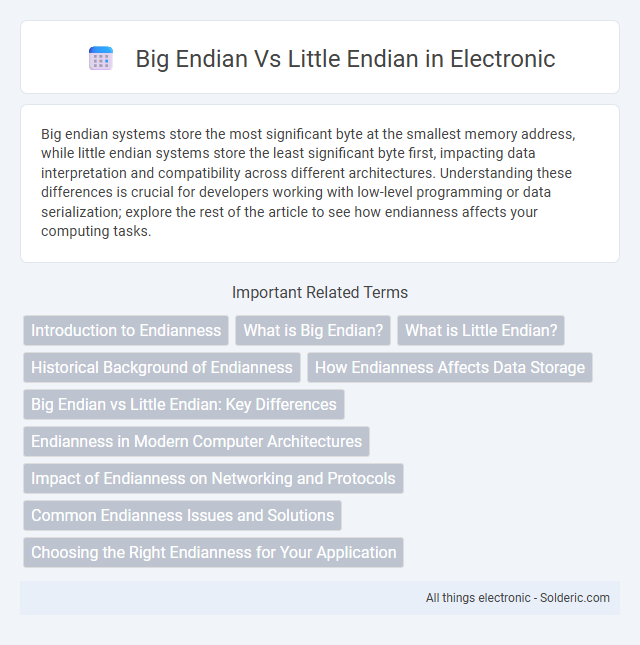Big endian systems store the most significant byte at the smallest memory address, while little endian systems store the least significant byte first, impacting data interpretation and compatibility across different architectures. Understanding these differences is crucial for developers working with low-level programming or data serialization; explore the rest of the article to see how endianness affects your computing tasks.
Comparison Table
| Aspect | Big Endian | Little Endian |
|---|---|---|
| Byte Order | Most significant byte stored at the smallest memory address | Least significant byte stored at the smallest memory address |
| Memory Storage | High-order byte first | Low-order byte first |
| Use Cases | Network protocols (e.g., TCP/IP), IBM mainframes, Motorola processors | Intel x86, x86-64 architectures, ARM processors (commonly) |
| Readability | Matches human-readable digit order (left to right) | Reverses human-readable digit order |
| Performance | No intrinsic performance advantage | No intrinsic performance advantage |
| Endianness Conversion | Requires swapping bytes when interacting with Little Endian systems | Requires swapping bytes when interacting with Big Endian systems |
Introduction to Endianness
Endianness refers to the order in which bytes are stored or transmitted in computer memory, with Big Endian storing the most significant byte first and Little Endian storing the least significant byte first. Understanding endianness is crucial for data interoperability across different systems and architectures, influencing how multi-byte data types like integers are interpreted. Your choice of endianness impacts system compatibility, data serialization, and network communication protocols.
What is Big Endian?
Big Endian is a byte order format where the most significant byte (MSB) is stored at the smallest memory address, making it the first in the sequence. This format is commonly used in network protocols like TCP/IP and in processor architectures such as PowerPC and SPARC. Understanding Big Endian is essential for data serialization, cross-platform communication, and interpreting binary data correctly.
What is Little Endian?
Little Endian is a data format where the least significant byte is stored at the smallest memory address, enabling efficient processing of multi-byte values on certain processor architectures like x86. This byte order contrasts with Big Endian, which stores the most significant byte first, making Little Endian particularly useful for systems requiring faster access to lower-order bytes. Understanding Little Endian helps you optimize data handling and interoperability in computing environments.
Historical Background of Endianness
Big endian and little endian formats originated from historical differences in computer architecture design, with big endian used by early IBM mainframes like the System/360 and little endian popularized by Intel's x86 processors. These endianness conventions dictate how bytes are ordered within multi-byte data types, influencing data interpretation and compatibility across systems. Understanding endianness is crucial for developers when handling low-level data operations, ensuring Your software communicates correctly between diverse hardware platforms.
How Endianness Affects Data Storage
Big endian stores the most significant byte at the smallest memory address, while little endian stores the least significant byte first, directly impacting how multi-byte data is interpreted and transferred across systems. Endianness determines byte order in memory, influencing data serialization, network communication, and file formats. Understanding your system's endianness ensures accurate data retrieval and prevents corruption when sharing binary data between different architectures.
Big Endian vs Little Endian: Key Differences
Big Endian stores the most significant byte at the smallest memory address, while Little Endian stores the least significant byte first. This difference impacts data interpretation and interoperability between systems, especially in network protocols and file formats. Understanding whether your system uses Big Endian or Little Endian is crucial for correctly processing binary data and ensuring compatibility.
Endianness in Modern Computer Architectures
Modern computer architectures utilize endianness to determine byte order in multi-byte data storage and transmission, with Big Endian storing the most significant byte first and Little Endian storing the least significant byte first. ARM and x86 processors predominantly use Little Endian formats, optimizing performance for common operations, whereas network protocols and some legacy systems prefer Big Endian for standardized communication. Understanding endianness is crucial for low-level programming, data serialization, and cross-platform interoperability in contemporary computing environments.
Impact of Endianness on Networking and Protocols
Endianness significantly affects data interpretation in networking and protocols, where Big Endian (network byte order) is the standard for transmitting multibyte values to ensure consistency across diverse systems. Protocols like TCP/IP and HTTP rely on this convention to maintain interoperability between devices with different internal byte orders, such as Little Endian architectures. Misalignment in byte order between sender and receiver can lead to incorrect data parsing, causing communication errors or security vulnerabilities in networked applications.
Common Endianness Issues and Solutions
Big endian and little endian systems often experience data misinterpretation during network communication and file sharing due to differing byte order conventions. Common issues include incorrect integer value representation and data corruption when transferring between architectures, such as ARM (little endian) and SPARC (big endian). Solutions involve standardizing data formats using network byte order (big endian), employing serialization libraries like Protocol Buffers, and implementing explicit byte swapping functions during data processing.
Choosing the Right Endianness for Your Application
Choosing the right endianness for your application depends on hardware architecture and data interchange requirements, with big-endian favored for network protocols and little-endian commonly used in x86 processors for efficient memory access. Developers must consider compatibility factors, such as cross-platform data sharing or system interoperability, to avoid byte order misinterpretation. Optimal endianness selection enhances performance and ensures data integrity across diverse computing environments.
Big endian vs Little endian Infographic

 solderic.com
solderic.com